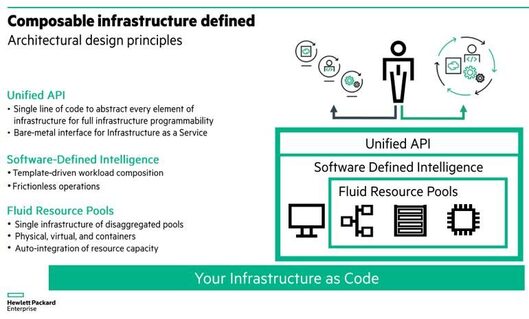 The DevOps community can celebrate. Heard of Composable Infrastructure? Well, you may better get used to this term. Hewlett Packard Enterprise (HPE) on Tuesday announced HPE Synergy, the first platform designed to run both traditional and cloud native applications for organizations seeking the benefits of running a hybrid infrastructure.
The DevOps community can celebrate. Heard of Composable Infrastructure? Well, you may better get used to this term. Hewlett Packard Enterprise (HPE) on Tuesday announced HPE Synergy, the first platform designed to run both traditional and cloud native applications for organizations seeking the benefits of running a hybrid infrastructure.
Based on groundbreaking new architecture developed by Hewlett Packard Enterprise, HPE Synergy leverages fluid resource pools, software defined intelligence and a unified API to provide the foundation for organizations to continually optimize the right mix of traditional and private cloud resources.
HPE Synergy physically brings together compute, storage and networking fabric, and through a single interface powered by HPE OneView, composes physical and virtual resources into any configuration for any application. As an extensible platform, it easily enables a broad range of applications and is ideal for customers looking to deploy a scalable hybrid cloud environment and enable continuous DevOps.
Organizations today have more opportunities than ever before to quickly deliver new applications and services, embrace new business models and enter new markets. Much of the pressure to deliver on these ambitions falls on the IT department, which must simultaneously extract more efficiencies and cost savings out of the traditional systems and applications that run their business, as well as provide a foundation for the rapid creation and delivery of new services through the use of mobile, big data and cloud native technologies.
Supporting these two very different operating models requires rethinking the way IT infrastructure is built. HPE Synergy addresses this challenge by leveraging a new architecture called Composable Infrastructure which consists of three key design principles:
- Fluid Resource Pools
- Compute, storage and fabric networking that can be composed and recomposed to the exact need of the application
- Boots up ready to deploy workloads
- Supports all workloads - Physical, Virtual and Containerized.
- Software Defined Intelligence
- Self-discovers and self-assembles the infrastructure you need
- Repeatable, frictionless updates
- A Unified API
- Single line of code to abstract every element of infrastructure
- 100% infrastructure programmability
- Bare-metal interface for Infrastructure as a Service

